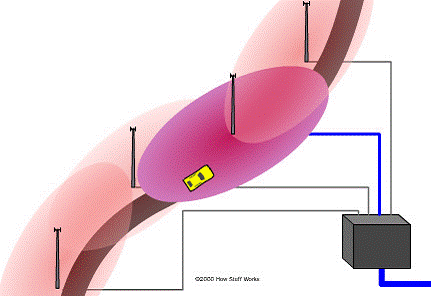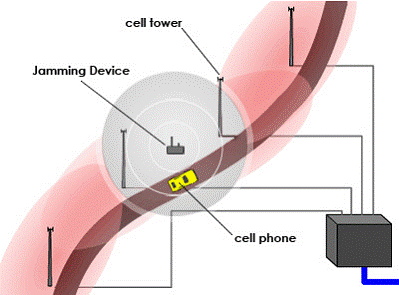





Published on Feb 21, 2020
A GSM Jammer or cell phone jammer is a device that transmit signal on the same frequency at which the GSM system operates, the jamming success when the mobile phones in the area where the jammer is located are disabled.
Communication jamming devices were first developed and used by military. Where tactical commanders use RF communications to exercise control of their forces, an enemy has interest in those communications. This interest comes from the fundamental area of denying the successful transport of the information from the sender to the receiver.
Nowadays the mobile jammer devices or cell phone jammer software are becoming civilian products rather than electronic warfare devices, since with the increasing number of the mobile phone users the need to disable mobile phones in specific places where the ringing of cell phone would be disruptive has increased. These places include worship places, university lecture rooms, libraries, concert halls, meeting rooms, and other places where silence is appreciated
Jamming devices overpower the cell phone by transmitting a signal on the same frequency as the cell phone and at a high enough power that the two signals collide and cancel each other out. Cell phones are designed to add power if they experience low-level interference, so the jammer must recognize and match the power increase from the phone. Cell phones are full-duplex devices, which mean they use two separate frequencies, one for talking and one for listening simultaneously. Some jammers block only one of the frequencies used by cell phones, which has the effect of blocking both.
The phone is tricked into thinking there is no service because it can receive only one of the frequencies. Less complex devices block only one group of frequencies, while sophisticated jammers can block several types of networks at once to head off dual-mode or tri-mode phones that automatically switch among different network types to find an open signal. Some of the high-end devices block all frequencies at once and others can be tuned to specific frequencies.
To jam a cell phone, all you need is a device that broadcasts on the correct frequencies. Although different cellular systems process signals differently, all cell-phone networks use radio signals that can be interrupted. GSM, used in digital cellular and PCS-based systems, operates in the 900-MHz and 1800-MHz bands in Europe and Asia and in the 1900-MHz (sometimes referred to as 1.9-GHz) band in the United States. Jammers can broadcast on any frequency and are effective against AMPS, CDMA, TDMA, GSM, PCS, DCS, iDEN and Nextel systems. Old-fashioned analog cell phones and today's digital devices are equally susceptible to jamming. Disrupting a cell phone is the same as jamming any other type of radio communication. A cell phone works by communicating with its service network through a cell tower or base station. Cell towers divide a city into small areas, or cells. As a cell phone user drives down the street, the signal is handed from tower to tower


A jamming device transmits on the same radio frequencies as the cell phone, disrupting the communication between the phone and the cell-phone base station in the town
It's a called a denial-of-service attack . The jammer denies service of the radio spectrum to the cell-phone users within range of the jamming device. Older jammers sometimes were
limited to working on phones using only analog or older digital mobile phone standards. Newer models such as the double and triple band jammers can block all widely used systems (AMPS, iDEN, GSM, etc) and are even very effective against newer phones which hop to different frequencies and systems when interfered with. As the dominant network technology and frequencies used for mobile phones vary worldwide, some work only in specific regions such as Europe or North America.
The power of the jammer's effect can vary widely based on factors such as proximity to towers, indoor and outdoor settings, presence of buildings and landscape, even temperature and humidity play a role. There are concerns that crudely designed jammers may disrupt the functioning of medical devices such as pacemakers. However, like cell phones, most of the devices in common use operate at low enough power output (<1W) to avoid causing any problems
In this device we overpower cell phone's signal with a stronger signal, This type of device comes equipped with several independent oscillators transmitting 'jamming signals' capable of blocking frequencies used by paging devices as well as those used by cellular/PCS systems' control channels for call establishment. When active in a designated area, such devices will (by means of RF interference) prevent all pagers and mobile phones located in that area from receiving and transmitting calls. This type of device transmits only a jamming signal and has very poor frequency selectivity, which leads to interference with a larger amount of communication spectrum than it was originally intended to target.
Technologist Jim Mahan said, "There are two types. One is called brute force jamming, which just blocks everything. The problem is, it's like power-washing the airwaves and it bleeds over into the public broadcast area. The other puts out a small amount of interference, and you could potentially confine it within a single cell block. You could use lots of little pockets of small jamming to keep a facility under control."
Unlike jammers, Type "B" devices do not transmit an interfering signal on the control channels. The device, when located in a designated 'quiet' area, functions as a 'detector'. It has a unique identification number for communicating with the cellular base station. When a Type "B" device detects the presence of a mobile phone in the quiet room; the 'filtering' (i.e. the prevention of authorization of call establishment) is done by the software at the base station.
When the base station sends the signaling transmission to a target user, the device after detecting simultaneously the presence of that signal and the presence of the target user, signals the base station that the target user is in a 'quiet' room; therefore, do not establish the communication. Messages can be routed to the user's voice- mail box, if the user subscribes to a voice-mail service. This process of detection and interruption of call establishment is done during the interval normally reserved for signaling and handshaking. For 'emergency users', the intelligent detector device makes provisions for designated users who have emergency status. These users must pre-register their phone numbers with the service providers.
When an incoming call arrives, the detector recognizes that number and the call are established for a specified maximum duration, say two minutes. The emergency users are also allowed to make out going calls. Similarly, the system is capable of recognizing and allowing all emergency calls routed to "911".
It should be noted that the Type "B" detector device being an integral part of the cellular/PCS systems, would need to be provisioned by the cellular/PCS service providers or provisioned by a third-party working cooperatively with full support of the cellular/PCS service providers
| Are you interested in this topic.Then mail to us immediately to get the full report.
email :- contactv2@gmail.com |